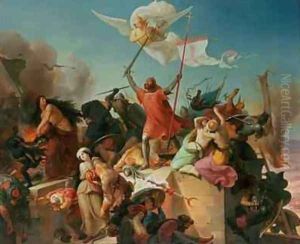Karl Mucke Paintings
Karl Mucke was a German painter, primarily known for his historical and genre paintings. Born on March 16, 1859, in Leobschütz, Silesia (now Głubczyce, Poland), Mucke received his artistic training at the Royal Art School in Breslau (now Wrocław, Poland) and later at the Academy of Fine Arts in Munich, where he was influenced by the academic and historical painting traditions of the 19th century.
Mucke's work often depicted scenes from history with a particular focus on the Middle Ages, as well as romanticized genre scenes that were popular among the bourgeois clientele of the era. His paintings are characterized by their detailed representation, rich color palette, and often idealized portrayal of their subjects. Mucke was also known to have an interest in the depiction of folklore and peasant life, which was a common theme among many artists of his time as a reaction to the rapid industrialization and urbanization of Germany.
While he was not as widely known as some of his contemporaries, Karl Mucke enjoyed a successful career and his works were exhibited in various art exhibitions throughout Germany. He was a part of the Munich School, a group of like-minded artists who were based in or connected to Munich and who shared an interest in genre painting and the use of light and color.
Karl Mucke's paintings are now housed in several regional museums in Germany and occasionally appear in art auctions. Despite the fact that he was not a leading figure in the art world, his work provides insight into the artistic trends and social currents of his time, particularly the interest in historical themes and the everyday life of people in the past.
Mucke's life spanned significant historical events, including both World Wars, which may have influenced both the market for his work and the subjects he chose to depict. Karl Mucke passed away in 1947, leaving behind a body of work that continues to be of interest to historians and collectors of 19th-century German art.
